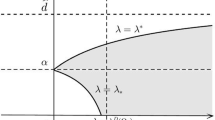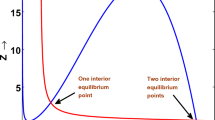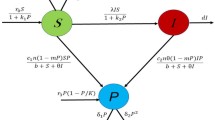Abstract
The well-known predator-prey model is modified in two ways. First, the regular adding or regular deleting of preys or/and predators is considered. The steady-state and stability diagram are found. Second, random fluctuations of the birthrate and other kinetic coefficients are studied, and the parabolic law of a random walk in the (X,Y)-space is found and proved for small deviations from the steady state.
Similar content being viewed by others
References
H. Haken, Advanced Synergetics: Instability Hierarchies of Self-Organizing Systems and Devices, Springer Sci. & Business Media, New York, 2012.
L. Edelstein-Keshet, Mathematical Models in Biology, SIAM, Philadelphia, 2005.
S. H. Strogatz, Nonlinear Dynamics and Chaos: with Applications to Physics, Biology, Chemistry, and Engineering, CRC Press, Boca Raton, 2018.
A. S. Mikhailov and A. Yu. Loskutov, Foundations of Synergetics, Vols. I, II, Springer, Berlin, 1994, 1996.
L. Arnold, W. Horsthemke, and J. Stucki, “The influence of external real and white noise on the Lotka– Volterra model,” Biometrical J., 21, 451–471 (1979).
J. I. Tello and D. Wrzosek, “Predator-prey model with diffusion and indirect prey-taxis,” Math. Mod. .Meth. Appl. Sci., 26, 2129–2162 (2016).
X. Tang, Xiaosong, Y. Song, and T. Zhang, “Turing-Hopf bifurcation analysis of a predator-prey model with herd behavior and cross-diffusion,” Nonlin. Dynam., 86, 73–89 (2016).
L. Zu, J. Daqing, and D. O’Regan, “Conditions for persistence and ergodicity of a stochastic Lotka–Volterra predator-prey model with regime switching,” Comm. Nonlin. Sci. Numer. Simul., 29, 1–11 (2015).
Z. Erdélyi, M. Pasichnyy, V. Bezpalchuk, J. J. Tomán, B. Gajdics, and A. M. Gusak, “Stochastic kinetic mean field model,” Computer Phys. Comm., 204, 31–37 (2016).
A. Gusak, T. Zaporozhets, and N. Storozhuk, “Phase competition in solid-state reactive diffusion revisitedstochastic kinetic mean-field approach,” J. Chem. Phys., 150, 174109 (2019).
R. Z. Khasminskii and F. C. Klebaner, “Long term behavior of solutions of the Lotka-Volterra system under small random perturbations,” Ann. Appl. Probab., 11, 952–963 (2001).
Author information
Authors and Affiliations
Corresponding author
Additional information
Translated from Ukrains’kiĭ Matematychnyĭ Visnyk, Vol. 16, No. 4, pp. 536–556 October–December, 2019.
Rights and permissions
About this article
Cite this article
Huriev, Y., Gusak, A. “Predator and Prey” Model Revisited – Influence of External Fluxes and Noise. J Math Sci 246, 648–663 (2020). https://doi.org/10.1007/s10958-020-04770-9
Received:
Published:
Issue Date:
DOI: https://doi.org/10.1007/s10958-020-04770-9




